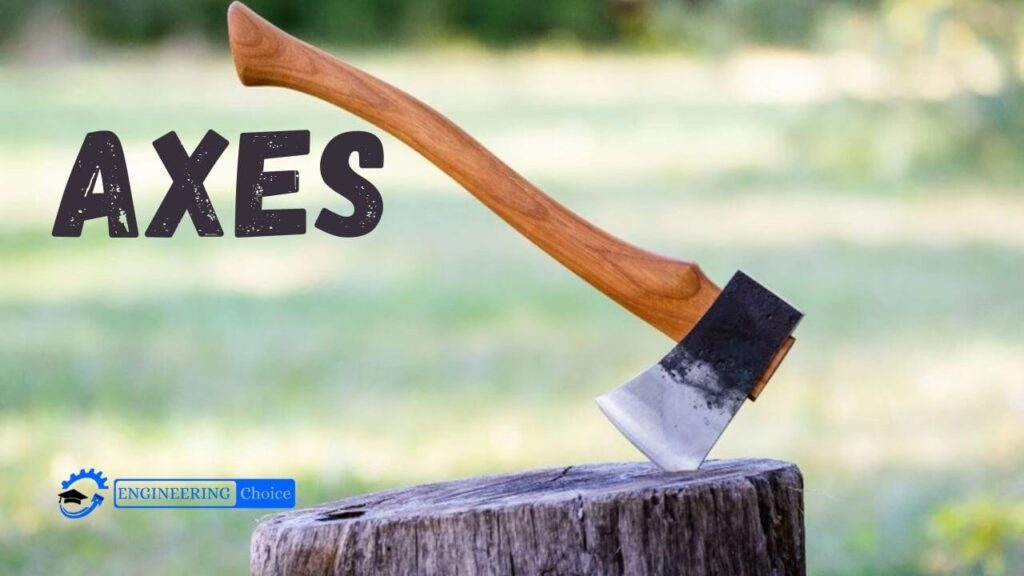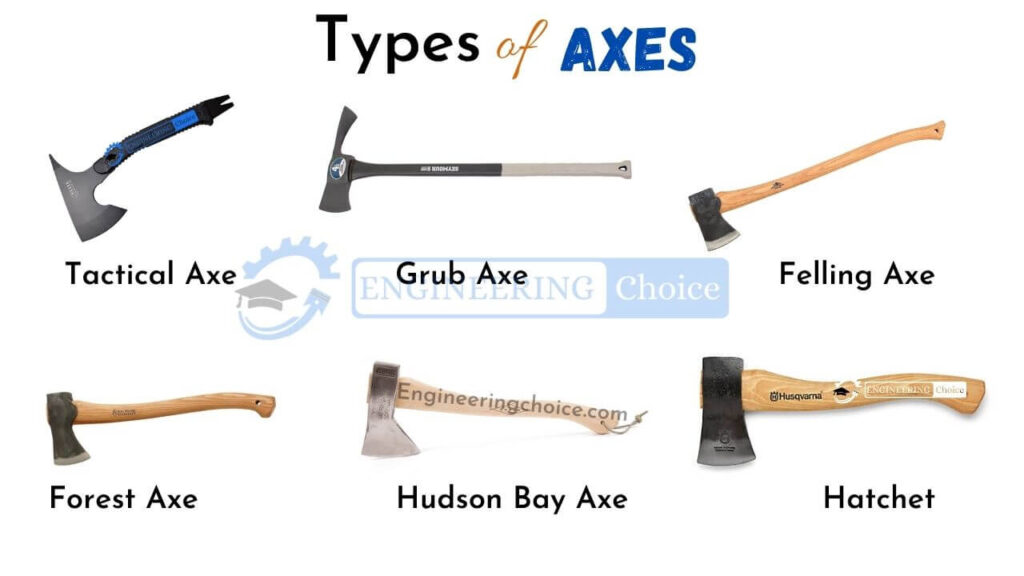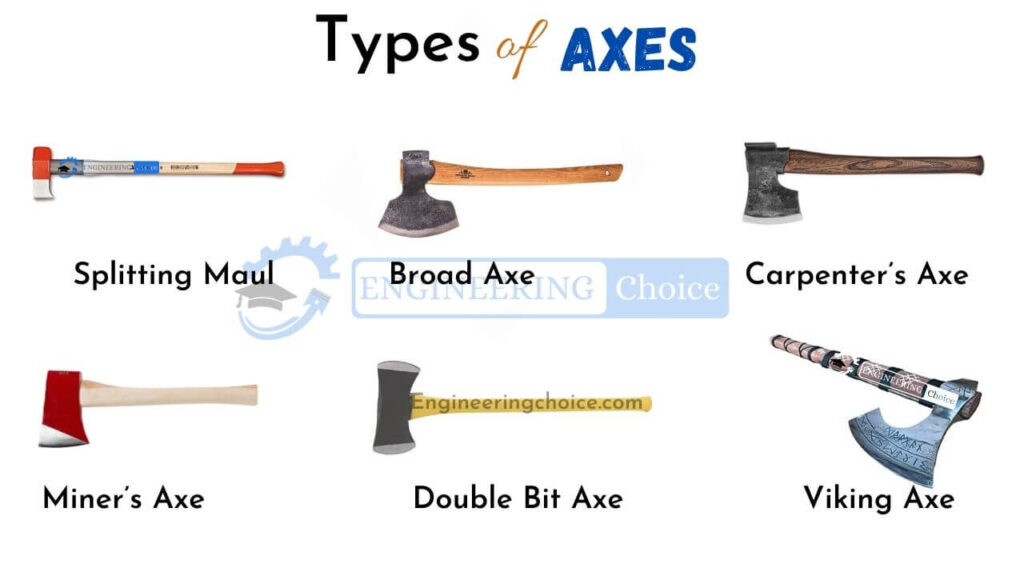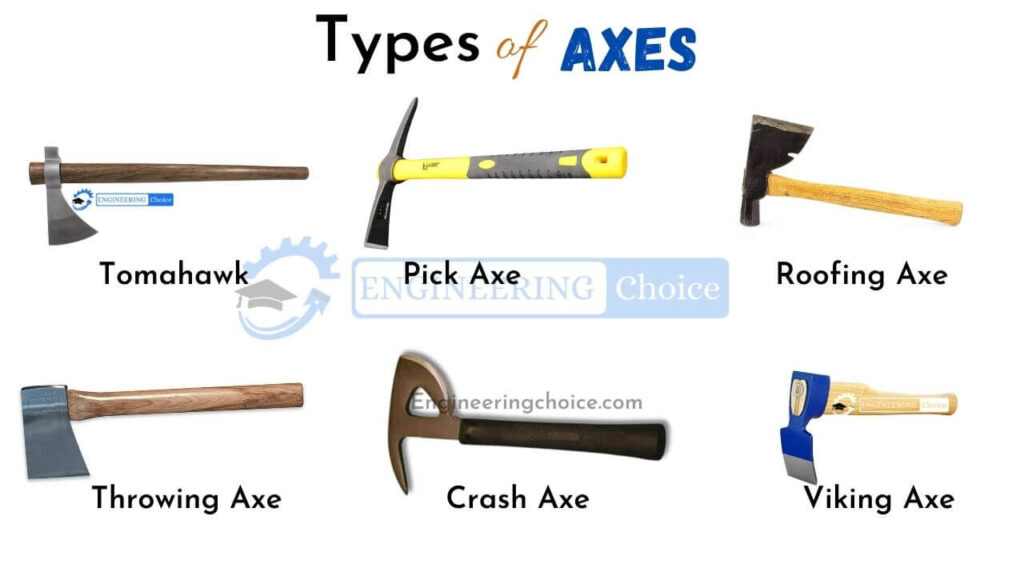What is an Axe?
An axe is an implement that has been used for millennia to shape, split and cut wood, harvest timber, as a weapon, and as a ceremonial or heraldic symbol. The axe has many forms and specialized uses but generally consists of an axe head with a handle or helve.
Before the modern axe, the stone-age hand axe without a handle was used from 1.5 million years BP. Hafted axes (those with a handle) date only from 6000 BC. The earliest examples of handled axes have heads of stone with some form of wooden handle attached (hafted) in a method to suit the available materials and use. Axes made of copper, bronze, iron, and steel appeared as these technologies developed.
The axe is an example of a simple machine, as it is a type of wedge or dual inclined plane. This reduces the effort needed by the woodchopper. It splits the wood into two parts by the pressure concentration at the blade.
The handle of the axe also acts as a lever allowing the user to increase the force at the cutting edge not using the full length of the handle is known as choking the axe. For fine chopping using a side axe sometimes is a positive effect, but for felling with a double-bitted axe it reduces efficiency.
Generally, cutting axes have a shallow wedge angle, whereas splitting axes have a deeper angle. Most axes are double beveled, i.e. symmetrical about the axis of the blade, but some specialist broadaxes have a single bevel blade, and usually an offset handle that allows them to be used for finishing work without putting the user’s knuckles at risk of injury.
Less common today, they were once an integral part of a joiner and carpenter’s tool kit, not just a tool for use in forestry. A tool of similar origin is the billhook.
Most modern axes have steel heads and wooden handles, typically hickory in the US and ash in Europe and Asia, although plastic or fiberglass handles are also common. Modern axes are specialized by use, size, and form.
Hafted axes with short handles designed for use with one hand are often called hand axes but the term hand axe refers to axes without handles as well. Hatchets tend to be small hafted axes often with a hammer on the backside.

Things You Should Consider When Searching a Perfect Axe
1. Handle
The best quality axes have wooden handles, though increasingly big box stores are selling axes with rubber handles. A wooden handle is more ergonomic and will last longer. For the best quality, look for a hickory or ash handle.
2. Weight
The weight of the axe head will affect its use. If it’s too heavy, you will gain force but lose accuracy, while if it’s too light, it won’t cut very deep. For your first axe, the head should weigh no more than three pounds, and you can work up to heavier bits with more experience.
3. Size
The ideal size of an axe handle is a much-debated topic and one that will largely be determined by its intended use. For a felling axe, a longer handle will give a greater swing and more leverage, but a shorter handle will result in better precision.
The standard length of a full-sized felling axe is 36 inches, but this should be the maximum length most users should consider. A person who is six feet tall would be best with a handle measuring around 32 inches, as this will offer a good balance between accuracy and force.
Types of Axes
There are many types of axes, they each have their own design, purpose, and history:
- Tactical Axe
- Grub Axe
- Felling Axe
- Forest Axe
- Hudson Bay Axe
- Hatchet
- Splitting Maul
- Broad Axe
- Carpenter’s Axe
- Miner’s Axe
- Double Bit Axe
- Viking Axe
- Tomahawk
- Pick Axe
- Roofing Axe
- Hunter’s Axe
- Throwing Axe
- Crash Axe
- Adze

1. Tactical Axe
The tactical axe is a modern invention, which is something of a multi-tool. Also commonly known as a tactical tomahawk, this axe has gained popularity among law enforcement officers, soldiers, and security staff, as well as survivalists.
Axes excel at chopping, splitting, shaving and more, plus they can be used for many of the same chores as an edged tool. The handle or grip is typically more ergonomic in shape and sometimes offers multiple hand positions and an axe or its little brother, the hatchet, is typically heavier to help facilitate chopping.
2. Grub Axe
A mattock /ˈmætək/ is a hand tool used for digging, prying, and chopping. Similar to the pickaxe, it has a long handle and a stout head which combines either a vertical axe blade with a horizontal adze (cutter mattock), or a pick and an adze (pick mattock). It is also commonly known in North America as a “grub axe”
The name ‘grub axe’ comes from the way the tool is used, as it is great for grubbing in compacted soils and rough terrain. These tools are very useful in the garden, as they can dig holes to set new plants in or break up resistant roots of old plants
3. Felling Axe
These axes are specifically designed for felling trees and chopping logs of wood. The head of a felling axe will weigh between two and four pounds, and sit at the end of a long handle. This long handle enables the user to produce a more powerful swing with greater leverage, making for a better cut. Traditionally the handles are made from hickory wood, which is strong. The grain of the hickory should follow the handle lengthways and curve along with it, for superior strength.
The felling axe, which has a long narrow blade, was used to chop down trees as it has a more elongated and rigid blade excellent for deep, gouging cuts. As the palisade walls of James Fort were built from upright logs, tools like this felling axe and broad axes were a necessary part of the colonial tool kit.
4. Forest Axe
Forest axes are robust axes that are solely used for felling trees. They are extremely heavy-duty tools and are too cumbersome to carry around on camping trips, but it would be great to store permanently at a cabin in the woods. These axes have extra long handles and are intended to cut down very large trees. A forest axe will have a sharp and flared blade with a slightly curved tip.
The distinguishing feature of Forest Axes is a long, rounded edge, with a flat elongated axe head. Forest Axes are specially designed to cut across the grain of the wood fibers, for example when felling and lambing, in contrast to log splitting, where the axe goes along the grain of the wood fibers.
5. Hudson Bay Axe
The history of the axe dates back thousands of years. The axe is one of the oldest hand tools used by man. Its uses vary from shaping or splitting wood to harvesting timber and as weapons, ceremonial purposes and status symbols.
Hudson Bay Axe is thought to have originated from “Biscayan” in Northern Spain, near France. French traders used this hand axe as a trade tool in their dealings with Native Americans for fur and other commodities in the Hudson Bay area, St. Lawrence River, and other trade routes.
Although today many people rely heavily on power tools, there are many who would not trade a good axe for all the chainsaws in the world. After all, an axe needs no gas or electricity, and if taken care of will be passed on for generations to come.
6. Hatchet
A hatchet (from the Old French hachete, a diminutive form of hache, ‘axe’ of Germanic origin) is a single-handed striking tool with a sharp blade on one side used to cut and split wood, and a hammerhead on the other side.
A hatchet is a general all-purpose axe, and is the kind of axe that most people own for light jobs in the yard. These can range enormously in price, from just a few dollars to $100+. They are relatively small compared to some other axes, with a chunky handle most commonly made from hickory wood.
The head is weighted, with a flared shape that comes to a sharp-tipped blade. Balance is very important for a good hatchet, as an overall balanced feel will help to produce more accurate swings and cuts, making jobs much quicker and easier to complete. A hatchet is used for felling small trees, and for chopping and splitting logs.
7. Splitting Maul
These axes are specifically designed for splitting logs into kindling. They have a design very similar to a felling axe, with a long wooden handle to give a good swing. When using a splitting maul, you should use a downward swing, not a sideways swing like that used for a felling axe.
Unlike felling axes, which cut against the grain of the wood, splitting mauls cut with the grain, which is what results in split wood rather than chopped wood. The head of a splitting maul will be much heavier than a felling axe, at around eight pounds.
The head takes the shape of a chunky wedge, with one sharp end and one blunt end, though the sharp end doesn’t need to be particularly sharp in order to be functional, as it is the shape and weight of the blade that will do most of the work. Because of this, splitting mauls need to be sharpened much less frequently than other axes, as they can work well even when fairly blunt.
8. Broad Axe
One of most essential tools in early America was the broad axe. The broad axe was used for squaring round logs into beams that would be used in a variety of buildings; including houses, barns, shops, and outbuildings. This tool should not be confused with the felling axe.
A broadaxes is a large-(broad) headed axe. There are two categories of cutting edge on broadaxes, both are used for shaping logs by hewing. On one type, one side is flat and the other side beveled, a basil led edge, also called a side axe, single bevel, or chisel-edged axe.
On the other type, both sides are beveled, sometimes called a double bevel axe, which produces a scalloped cut. On the basil-led broadaxes, the handle may curve away from the flat side to allow an optimal stance by the hewer in relation to the hewn surface. The flat blade is to make the flat surface but can only be worked from one direction and are right-handed or left-handed. The double bevel axe has a straight handle can be swung with either side against the wood.
A double-beveled broad axe can be used for chopping or notching and hewing. When used for hewing, a notch is chopped in the side of the log down to a marked line, called scoring. The pieces of wood between these notches are removed with an axe called joggling[3] and then the remaining wood is chopped away to the line.
9. Carpenter’s Axe
Carpenter’s axes or Carpenter’s hatchets are small axes, usually slightly larger than a hatchet, used in traditional woodwork, joinery and log-building. They have pronounced beards and finger notches to allow a “choked” grip for precise control.
Carpentry axes have straight, long cutting edges and thin blades with a low bevel angle, making them ideal for working with dry wood. These axes also have straight handles, as the curved handles typical of felling and chopping axes would get in the way of the smaller more precise cuts that tend to be made with carpentry axes. These features allow carpenters axes to be capable of detailed work such as cutting a plank’s end to a desired angled with a planed surface and even rudimentary woodcarving.
The long straight edge of carpentry axes provides a good degree of stability when cutting as well as being the ideal shape for guiding the blade by eye.
The poll is generally designed for use as a hammer and newer carpenter’s hatchets will often have a groove for pulling nails.

10. Miner’s Axe
This axe was originally used by miners in the Middle Ages while mining for copper and silver ore in Europe. These axes feature a short handle and a long head, which are ideal for use in close quarters. Gradually over the centuries, these axes became a status symbol among miners, and may have intricately detailed engraving on the head of the axe.
11. Double Bit Axe
The Double Bit Axe has a two-sides for cutting, chopping and splitting. Keep one side razor sharp for chopping and cutting, and keep the other side more dull and blunt for splitting. Lightweight and the perfect size for camping or backpacking.
The advantage of a double-bitted axe comes in the fact that each bit can be maintained at a different sharpness and bevel, reducing the number of axes that need to be taken into the woods. The type chosen often comes down to personal preference.
12. Viking Axe
The Viking axe was a very common weapon. Everyone owned a woodcutting axe that could be used as a dangerous weapon. Other axes were designed specifically for war.
Viking axes were used throughout the Viking Age as battle weapons. Though it is true that many Viking axes were large, you’d be wrong to assume they were brutish and cumbersome. Well-made Viking axes were exceptionally well balanced and could weigh less than two pounds, making them light to carry during battle, and swift to use. The size of these axes varied greatly, though most were double-handed, with handles being as long as 55 inches.
The heads on Viking axes could be varying shapes, but predominantly they are noted for being heavily bearded. This shape was useful for a variety of things in battle, such as hooking an opponent’s ankle to trip them over or hooking their shield out of the way to render them defenseless.
The tips of the blade would be incredibly sharp so that they could slash throats like with a knife, and the blunt butt of an axe would also be utilized, usually to bang someone on the head to cause a humiliating but not lethal blow. The heads were almost always made from iron, while the handles were wooden. These types of axes are no longer used today; instead, they are studied to learn about past civilizations.
13. Tomahawk
A tomahawk is a type of single-handed axe native to the many Indigenous peoples and nations of North America, traditionally resembling a hatchet with a straight shaft. The term came into the English language in the 17th century as an adaptation of the Powhatan (Virginian Algonquian) word.
Tomahawks were general-purpose tools used by Native Americans and later the European colonials with whom they traded, and often employed as a hand-to-hand weapon. The metal tomahawk heads were originally based on a Royal Navy boarding axe and used as a trade-item with Native Americans for food and other provisions
14. Pick Axe
A pickaxe, pick-axe, or pick is a generally T-shaped hand tool used for prying. Its head is typically metal, attached perpendicularly to a longer handle, traditionally made of wood, occasionally metal, and increasingly fiberglass.
A standard pickaxe, similar to a “pick mattock”, has a pointed end on one side of its head and a broad flat “axe” blade opposite. A gradual curve characteristically spans the length of the head. The next most common configuration features two spikes, one slightly longer than the other.
The pointed end is used both for breaking and prying, the axe for hoeing, skimming, and chopping through roots.
Developed as agricultural tools in prehistoric times, picks have evolved into other tools such as the plough and the mattock. They also have been used in general construction and mining, and adapted to warfare.
15. Roofing Axe
Roofing hammers and hatchets are specialized tools intended to help residential roofers cut shingles and drive nails into them. They have unique features to make this job more efficient, such as magnetized faces to help you pick up a stray nail and even gauges that help you position shingles with the right exposure.
A roofing axe, also known as a roofing hatchet, is a high-quality craftsman’s tool which is used in roofing, and though it has fallen out of favor due to modern inventions, many roofers still prefer this traditional roofing tool.
A roofing axe has multiple purposes, which is great if you’re sat on top of a roof and don’t want to be carrying around a bunch of different tools. The roofing axe has two heads on either side of the handle. One head is a sharp blade that is used for cutting roof shingles.
The other head is a hammer, which is for pounding in roofing nails when fixing shingles to the roof. Often, the hammerhead will be magnetized, so you won’t need to hold the nails in place, and instead just attach them to the front of the hammer and jam them in. Roofing axes also have an additional feature, in the form of a node on the sharp blade side.
This node is a shingle gauge, which can be used by hooking it over the front face of the shingle below the one you are setting, with the hammerhead pointing upwards. The next shingle should sit up against the hammerhead, giving you evenly placed rows of shingle.
16. Hunter’s Axe
The Hunters Axe is specifically made for hunters. The Poll is forged thinner than normal and is gently rounded and burnished to a Flay Poll to be used when skinning an animal. The axe is good for chopping in wood as well as meat and bone.
A hunter’s axe is the essential tool for a hunter, serving the dual purpose of chopping wood and meat. A good hunter’s axe will have a grooved handle, which improves grip even if the user’s hands are wet or sticky, be it from rain or animal blood.
An ordinary axe would not work well to skin an animal, as the straight poll with sharp corners is likely to inadvertently damage the animal hide. By comparison, a hunter’s axe has a rounded ‘flay poll,’ which will be more useful for animal skinning. This type of axe is not widely available, and you would need to find a specialist forger to buy a hunter’s axe.

17. Throwing Axe
A hurlbat (or whirlbat, whorlbat) is the term used for a type of weapon with unclear original definition. Older reference works refer to it largely as a type of club, either held in the hand or possibly thrown. Modern usage appears to refer to a type of throwing-axe.
The original throwing axe was used by foot soldiers in the middle ages as a weapon in battle, which was thrown at an opponent to cause fatal damage. In recent years, axe throwing has been introduced as a competitive sport that is growing in popularity.
The axes used in this sport can vary in type and design, but their main feature is that they need to be incredibly durable and sturdy so that they can cope with the pressure they are put under from numerous throws.
The handle of a throwing axe will need to measure a certain length in order to meet the requirements set by the league or federation, which is hosting the sport. You can get different axes for throwing depending on your level in the sport, for example, beginner to intermediate axes, or more professional axes for those more experienced in axe throwing. These axes vary in price range, though typically, the more you spend, the better quality of axe you will receive.
18. Crash Axe
The Crash Axe is designed as a flexible multi-use tool. It has a lightweight, high-strength titanium handle with replaceable heads, such as a stainless steel crash axe blade and a stainless steel pike. The hilt has a metal cutting claw and a wire-cutter.
A crash axe is an emergency tool that is typically used in the event of an aircraft crash landing. These axes are a handheld tool with a short handle and a very sharp smooth, or serrated blade. The blade will need to be able to slice through sheet metal in order to gain access to the aircraft from the outside or to cut a hole in the aircraft from the inside to create an exit if other exits are blocked.
A crash axe can also pry gaps open and chop interior walls and overhead cabinets. A crash axe must be carried in the cockpit or every aircraft which has 20 or more passenger seats in case of an emergency.
Some types of crash axe have a notch upon the blade, which can be used to hook onto sheet metal, while others may have a separate head with a pick on it. These types of axes are typically made entirely from metal and are not commonly owned by anyone outside of the emergency services.
19. Adze
An adze (/ædz/; alternative spelling: adz) is an ancient and versatile cutting tool similar to an axe but with the cutting edge perpendicular to the handle rather than parallel. They have been used since the Stone Age. Adzes are used for smoothing or carving wood in hand woodworking, and as a hoe for agriculture and horticulture.
Two basic forms of an adze are the hand adze (short hoe) a short-handled tool swung with one hand and the foot adze (hoe), a long-handled tool capable of powerful swings using both hands, the cutting edge usually striking at foot or shin level. A similar tool is called a mattock, which differs by having two blades, one perpendicular to the handle and one parallel.
FAQs
What are the three types of axes?
The Carpenter’s Axe is not suitable for heavier work such as tree felling and log splitting. The pointed angle of the blade is not designed for that. Nowadays, axes are used primarily as tools and form three main groups: Forest Axes, Splitting Axes and Log-building Axes.
What is a felling axe for?
A felling axe, as the name suggests, is primarily designed for the task of felling trees. It typically has a long handle, usually around 28-36 inches, which provides leverage and power to make deep cuts into the tree trunk.
What are the different types of axe tools?
Various Types of Axes:
1. Tactical Axe.
2. Grub Axe.
3. Felling Axe.
4. Forest Axe.
5. Hudson Bay Axe.
6. Hatchet.
7. Splitting Maul.
8. Broad Axe.
What is a heavy axe called?
Broad Axe. The broad axe is a large, heavy axe with a wide blade. It is commonly used in woodworking for shaping and hewing logs. This type of axe features a single beveled blade that is flat on one side and curved on the other.
What are the 3 primary axes?
The aircraft yaws around the vertical axis with the rudder.
1. Lateral Axis and Pitch. That lateral axis of the airplane runs from wingtip to wingtip.
2. Longitudinal Axis and Roll. The airplane’s longitudinal axis runs from the tip of the nose to the tip of the tail.
3. Vertical Axis and Yaw. The vertical axis of the airplane runs up and down through the CG.
What is a fireman’s axe called?
The Pulaski is a specialty hand tool used in fighting fires, particularly wildfires, which combines an axe and an adze in one head. Similar to a cutter mattock, it has a rigid handle of wood, plastic, or fiberglass.